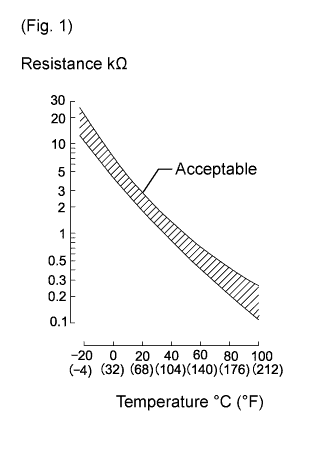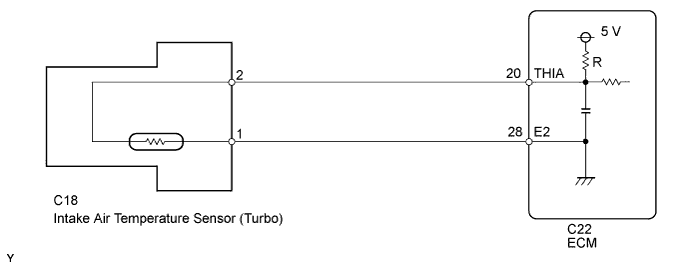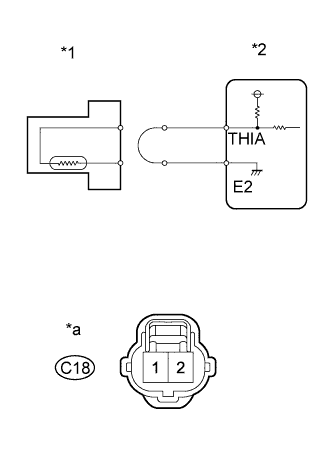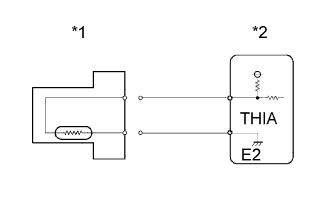DESCRIPTION
WIRING DIAGRAM
INSPECTION PROCEDURE
READ VALUE USING INTELLIGENT TESTER (INTAKE AIR TEMPERATURE [TURBO])
READ VALUE USING INTELLIGENT TESTER (CHECK FOR OPEN IN WIRE HARNESS)
CHECK HARNESS AND CONNECTOR (INTAKE AIR TEMPERATURE SENSOR - ECM)
READ VALUE USING INTELLIGENT TESTER (CHECK FOR SHORT IN WIRE HARNESS)
CHECK HARNESS AND CONNECTOR (INTAKE AIR TEMPERATURE SENSOR [TURBO] - ECM)
REPLACE ECM
CONFIRM GOOD CONNECTION TO SENSOR. IF OK, REPLACE INTAKE AIR TEMPERATURE SENSOR (TURBO).
REPAIR OR REPLACE HARNESS OR CONNECTOR
CONFIRM GOOD CONNECTION TO ECM. IF OK, REPLACE ECM.
REPLACE INTAKE AIR TEMPERATURE SENSOR (TURBO)
CONFIRM WHETHER MALFUNCTION HAS BEEN SUCCESSFULLY REPAIRED
DTC P0095 Intake Air Temperature Sensor 2 Circuit |
DTC P0097 Intake Air Temperature Sensor 2 Circuit Low |
DTC P0098 Intake Air Temperature Sensor 2 Circuit High |
DESCRIPTION
 The Intake Air Temperature (IAT) sensor detects the IAT after the intake air passes through the intercooler. A built-in thermistor in the sensor changes its resistance value according to the intake air temperature. The lower the intake air temperature, the higher the thermistor resistance value. The higher the intake air temperature, the lower the thermistor resistance value (See Fig. 1).The sensor is connected to the ECM. The 5 V power source voltage in the ECM is applied to the sensor from terminal THIA via resistor R. Resistor R and the sensor are connected in series. When the resistance value of the sensor changes in accordance with changes in the IAT, the potential at terminal THIA also changes. Based on this signal, the ECM corrects the fuel injection volume to improve driveability with a cold engine.
The Intake Air Temperature (IAT) sensor detects the IAT after the intake air passes through the intercooler. A built-in thermistor in the sensor changes its resistance value according to the intake air temperature. The lower the intake air temperature, the higher the thermistor resistance value. The higher the intake air temperature, the lower the thermistor resistance value (See Fig. 1).The sensor is connected to the ECM. The 5 V power source voltage in the ECM is applied to the sensor from terminal THIA via resistor R. Resistor R and the sensor are connected in series. When the resistance value of the sensor changes in accordance with changes in the IAT, the potential at terminal THIA also changes. Based on this signal, the ECM corrects the fuel injection volume to improve driveability with a cold engine.P0095DTC Detection Drive Pattern
| DTC Detection Condition
| Trouble Area
|
Ignition switch to ON for 1 second
| Open or short in the intake air temperature sensor (turbo) circuit for 0.5 seconds (1 trip detection logic).
| - Open or short in intake air temperature sensor (turbo) circuit
- Intake air temperature sensor (turbo)
- ECM
|
P0097DTC Detection Drive Pattern
| DTC Detection Condition
| Trouble Area
|
Ignition switch to ON for 1 second
| Short in the intake air temperature sensor (turbo) circuit for 0.5 seconds (1 trip detection logic).
| - Short in intake air temperature sensor (turbo) circuit
- Intake air temperature sensor (turbo)
- ECM
|
P0098DTC Detection Drive Pattern
| DTC Detection Condition
| Trouble Area
|
Ignition switch to ON for 1 second
| Open in the intake air temperature sensor (turbo) circuit for 0.5 seconds (1 trip detection logic).
| - Open in intake air temperature sensor (turbo) circuit
- Intake air temperature sensor (turbo)
- ECM
|
Related Data ListDTC No.
| Data List
|
P0095
| Intake Air Temp (Turbo)
|
P0097
|
P0098
|
- HINT:
- If DTC P0095, P0097 and/or P0098 is stored, the following symptoms may appear:
- Misfire
- Combustion noise
- Black smoke
- White smoke
- Lack of power
- When DTC P0095, P0097 and/or P0098 is stored, check the intake air temperature by entering the following menus: Powertrain / Engine and ECT / Data List / Intake Air Temp (Turbo).
ReferenceTemperature Displayed
| Malfunction
|
-40°C (-40°F)
| Open circuit
|
140°C (284°F) or higher
| Short circuit
|
WIRING DIAGRAM
INSPECTION PROCEDURE
- NOTICE:
- After replacing the ECM, the new ECM needs registration (HILUX_TGN26 RM0000012XK05BX.html) and initialization (HILUX_TGN26 RM000000TIN04CX.html).
- HINT:
- Read freeze frame data using the intelligent tester. Freeze frame data records the engine condition when malfunctions are detected. When troubleshooting, freeze frame data can help determine if the vehicle was moving or stationary, if the engine was warmed up or not, and other data from the time the malfunction occurred.
| 1.READ VALUE USING INTELLIGENT TESTER (INTAKE AIR TEMPERATURE [TURBO]) |
Connect the intelligent tester to the DLC3.
Turn the ignition switch to ON and turn the tester on.
Enter the following menus: Powertrain / Engine and ECT / Data List / Intake Air Temp (Turbo).
Read the value.
- OK:
- Same as air temperature near intake manifold
ResultResult
| Proceed to
|
-40°C (-40°F)
| A
|
140°C (284°F) or higher
| B
|
OK (same as air temperature near intake manifold)
| C
|
- HINT:
- If there is an open circuit, the tester indicates -40°C (-40°F).
- If there is a short circuit, the tester indicates 140°C (284°F) or higher.
| 2.READ VALUE USING INTELLIGENT TESTER (CHECK FOR OPEN IN WIRE HARNESS) |
Disconnect the intake air temperature sensor (turbo) connector.
Connect terminals 1 and 2 of the intake air temperature sensor (turbo) wire harness side connector.
Connect the intelligent tester to the DLC3.
Turn the ignition switch to ON and turn the tester on.
Enter the following menus: Powertrain / Engine and ECT / Data List / Intake Air Temp (Turbo).
Read the value.
- OK:
- 140°C (284°F) or higher
Text in Illustration*1
| Intake Air Temperature Sensor (Turbo)
|
*2
| ECM
|
*a
| Front view of wire harness connector
(to Intake Air Temperature Sensor [Turbo])
|
Reconnect the intake air temperature sensor (turbo) connector.
| 3.CHECK HARNESS AND CONNECTOR (INTAKE AIR TEMPERATURE SENSOR - ECM) |
Disconnect the intake air temperature sensor (turbo) connector.
Disconnect the ECM connector.
Measure the resistance according to the value(s) in the table below.
- Standard Resistance:
Tester Connection
| Condition
| Specified Condition
|
C18-2 - C22-20 (THIA)
| Always
| Below 1 Ω
|
C18-1 - C22-28 (E2)
| Always
| Below 1 Ω
|
Reconnect the intake air temperature sensor (turbo) connector.
Reconnect the ECM connector.
| 4.READ VALUE USING INTELLIGENT TESTER (CHECK FOR SHORT IN WIRE HARNESS) |
Disconnect the intake air temperature sensor (turbo) connector.
Connect the intelligent tester to the DLC3.
Turn the ignition switch to ON and turn the tester on.
Enter the following menus: Powertrain / Engine and ECT / Data List / Intake Air Temp (Turbo).
Read the value.
- OK:
- -40°C (-40°F)
Text in Illustration*1
| Intake Air Temperature Sensor (turbo)
|
*2
| ECM
|
Reconnect the intake air temperature sensor (turbo) connector.
| 5.CHECK HARNESS AND CONNECTOR (INTAKE AIR TEMPERATURE SENSOR [TURBO] - ECM) |
Disconnect the intake air temperature sensor (turbo) connector.
Disconnect the ECM connector.
Measure the resistance according to the value(s) in the table below.
- Standard Resistance:
Tester Connection
| Condition
| Specified Condition
|
C18-2 or C22-20 (THIA) - Body ground
| Always
| 10 kΩ or higher
|
Reconnect the intake air temperature sensor (turbo) connector.
Reconnect the ECM connector.
Replace the ECM (HILUX_TGN26 RM0000013Z001IX.html).
| 7.CONFIRM GOOD CONNECTION TO SENSOR. IF OK, REPLACE INTAKE AIR TEMPERATURE SENSOR (TURBO). |
Replace the intake air temperature sensor (turbo) (HILUX_TGN26 RM0000014XP019X.html).
| 8.REPAIR OR REPLACE HARNESS OR CONNECTOR |
Repair or replace the harness or connector.
| 9.CONFIRM GOOD CONNECTION TO ECM. IF OK, REPLACE ECM. |
Replace the ECM (HILUX_TGN26 RM0000013Z001IX.html).
| 10.REPLACE INTAKE AIR TEMPERATURE SENSOR (TURBO) |
Replace the intake air temperature sensor (turbo) (HILUX_TGN26 RM0000014XP019X.html).
| 11.CONFIRM WHETHER MALFUNCTION HAS BEEN SUCCESSFULLY REPAIRED |
Connect the intelligent tester to the DLC3.
Clear the DTCs (HILUX_TGN26 RM000000PDK0XBX.html).
Turn the ignition switch off for 30 seconds or more.
Turn the ignition switch to ON for 1 second.
Enter the following menus: Powertrain / Engine and ECT / DTC.
Confirm that the DTC is not output again.



